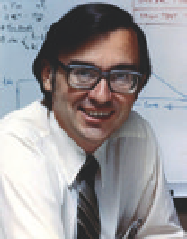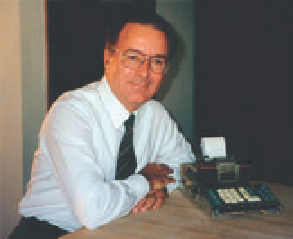Information Technology Reference
In-Depth Information
In the summer of 1969, the Japanese calculator manufacturer Busicom
asked Intel to design a set of chips for their new range of
programmable cal-
culators
, which could be programmed much like a computer. The Japanese
engineers had a design that involved twelve logic and memory chips, each
with several thousand transistors. Ted Hoff, the Intel engineer assigned to
the project, thought that this was not a very efficient solution to their prob-
lem. Instead, Hoff suggested developing a general-purpose logic chip that,
like the central processor of a computer, could be programmed to perform
any logical task (
B.7.9
). Together with some RAM and ROM, and a chip to con-
trol input and output, Hoff 's solution needed only four chips to be designed
instead of the original twelve. Intel engineers Stan Mazor and Frederico
Faggin, together with Busicom engineer Masatoshi Shima, implemented the
design (
Fig. 7.14
). This was the first
microprocessor
sold as a component - an IC
that can perform all of the functions of a computer's central processing unit
(CPU). At first Intel was not sure of the market for its microprocessor (called
the 4004) because the company thought that there was too little demand for
calculators. As it turned out, any machine that handled and manipulated
information or controlled a complex process was a potential market for the
microprocessor.
The Intel 4004 microprocessor was launched in 1971. It contained more
than two thousand transistors and measured 1/8 inch by 1/16 inch a side. This
single chip had about the same computing power as the original ENIAC com-
puter. Intel introduced a more powerful microprocessor called the 8080 in 1974.
The 8080 led to a host of new applications and, as we shall see in the next
chapter, to the creation of the personal computer. By the early 1980s Intel had
more than $1 billion in sales: twenty years later, the global market for micro-
processors was more than $40 billion. The vast majority of microprocessor chips
are used in “embedded” applications - such as in washing machines, cookers,
elevators, airbags, cameras, TVs, DVD players, and mobile phones. Automobiles
and planes are increasingly reliant on microprocessors, as are the many of the
infrastructure systems vital to the functioning of a modern city.
B.7.8. A photograph of Robert
Dennard from IBM. On the white
board behind him is a sketch of his
one-transistor DRAM cell. This led to
the widespread availability of cheap
semiconductor memory chips. His
clear statement of the consequences
of the physics behind Moore's law is
known as
Dennard scaling
.
B.7.9. The three inventors of Intel's first microprocessor, Ted Hoff, Stan Mazor, and Frederico
Faggin. Hoff was Intel employee number 12; he and colleagues Mazor and Faggin were awarded
the 2010 U.S. National Medal for Technology and Innovation. Faggin credits Masatoshi Shima, an
engineer from the Japanese company Busicom, for help with the detailed design work for
the 4004.





Search WWH ::

Custom Search